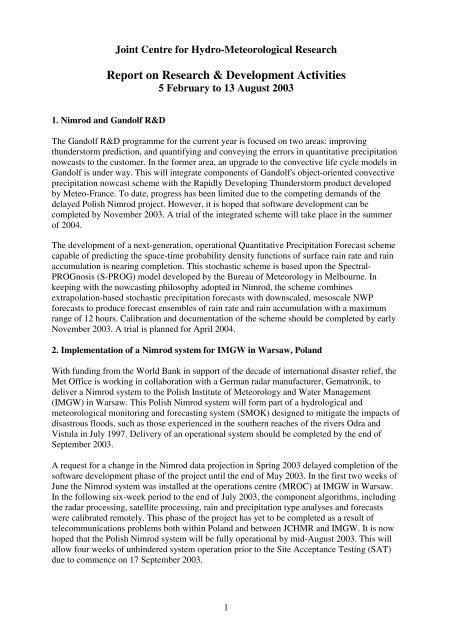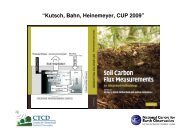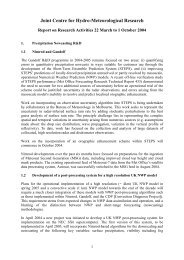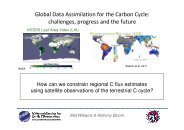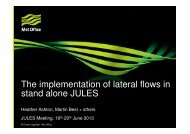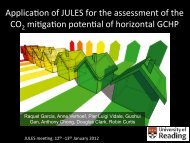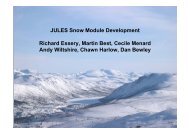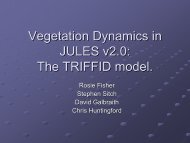here in PDF format - Joint Centre for Hydro-Meteorological Research
here in PDF format - Joint Centre for Hydro-Meteorological Research
here in PDF format - Joint Centre for Hydro-Meteorological Research
You also want an ePaper? Increase the reach of your titles
YUMPU automatically turns print PDFs into web optimized ePapers that Google loves.
Jo<strong>in</strong>t <strong>Centre</strong> <strong>for</strong> <strong>Hydro</strong>-<strong>Meteorological</strong> <strong>Research</strong><br />
Report on <strong>Research</strong> & Development Activities<br />
5 February to 13 August 2003<br />
1. Nimrod and Gandolf R&D<br />
The Gandolf R&D programme <strong>for</strong> the current year is focused on two areas: improv<strong>in</strong>g<br />
thunderstorm prediction, and quantify<strong>in</strong>g and convey<strong>in</strong>g the errors <strong>in</strong> quantitative precipitation<br />
nowcasts to the customer. In the <strong>for</strong>mer area, an upgrade to the convective life cycle models <strong>in</strong><br />
Gandolf is under way. This will <strong>in</strong>tegrate components of Gandolf's object-oriented convective<br />
precipitation nowcast scheme with the Rapidly Develop<strong>in</strong>g Thunderstorm product developed<br />
by Meteo-France. To date, progress has been limited due to the compet<strong>in</strong>g demands of the<br />
delayed Polish Nimrod project. However, it is hoped that software development can be<br />
completed by November 2003. A trial of the <strong>in</strong>tegrated scheme will take place <strong>in</strong> the summer<br />
of 2004.<br />
The development of a next-generation, operational Quantitative Precipitation Forecast scheme<br />
capable of predict<strong>in</strong>g the space-time probability density functions of surface ra<strong>in</strong> rate and ra<strong>in</strong><br />
accumulation is near<strong>in</strong>g completion. This stochastic scheme is based upon the Spectral-<br />
PROGnosis (S-PROG) model developed by the Bureau of Meteorology <strong>in</strong> Melbourne. In<br />
keep<strong>in</strong>g with the nowcast<strong>in</strong>g philosophy adopted <strong>in</strong> Nimrod, the scheme comb<strong>in</strong>es<br />
extrapolation-based stochastic precipitation <strong>for</strong>ecasts with downscaled, mesoscale NWP<br />
<strong>for</strong>ecasts to produce <strong>for</strong>ecast ensembles of ra<strong>in</strong> rate and ra<strong>in</strong> accumulation with a maximum<br />
range of 12 hours. Calibration and documentation of the scheme should be completed by early<br />
November 2003. A trial is planned <strong>for</strong> April 2004.<br />
2. Implementation of a Nimrod system <strong>for</strong> IMGW <strong>in</strong> Warsaw, Poland<br />
With fund<strong>in</strong>g from the World Bank <strong>in</strong> support of the decade of <strong>in</strong>ternational disaster relief, the<br />
Met Office is work<strong>in</strong>g <strong>in</strong> collaboration with a German radar manufacturer, Gematronik, to<br />
deliver a Nimrod system to the Polish Institute of Meteorology and Water Management<br />
(IMGW) <strong>in</strong> Warsaw. This Polish Nimrod system will <strong>for</strong>m part of a hydrological and<br />
meteorological monitor<strong>in</strong>g and <strong>for</strong>ecast<strong>in</strong>g system (SMOK) designed to mitigate the impacts of<br />
disastrous floods, such as those experienced <strong>in</strong> the southern reaches of the rivers Odra and<br />
Vistula <strong>in</strong> July 1997. Delivery of an operational system should be completed by the end of<br />
September 2003.<br />
A request <strong>for</strong> a change <strong>in</strong> the Nimrod data projection <strong>in</strong> Spr<strong>in</strong>g 2003 delayed completion of the<br />
software development phase of the project until the end of May 2003. In the first two weeks of<br />
June the Nimrod system was <strong>in</strong>stalled at the operations centre (MROC) at IMGW <strong>in</strong> Warsaw.<br />
In the follow<strong>in</strong>g six-week period to the end of July 2003, the component algorithms, <strong>in</strong>clud<strong>in</strong>g<br />
the radar process<strong>in</strong>g, satellite process<strong>in</strong>g, ra<strong>in</strong> and precipitation type analyses and <strong>for</strong>ecasts<br />
were calibrated remotely. This phase of the project has yet to be completed as a result of<br />
telecommunications problems both with<strong>in</strong> Poland and between JCHMR and IMGW. It is now<br />
hoped that the Polish Nimrod system will be fully operational by mid-August 2003. This will<br />
allow four weeks of unh<strong>in</strong>dered system operation prior to the Site Acceptance Test<strong>in</strong>g (SAT)<br />
due to commence on 17 September 2003.<br />
1
3. Ra<strong>in</strong>fall Collaboration Project<br />
T<strong>here</strong> are currently about 60 Environment Agency ra<strong>in</strong>gauges report<strong>in</strong>g rout<strong>in</strong>ely to the Met<br />
Office from three regions. Data acquisition from the rema<strong>in</strong><strong>in</strong>g regions has cont<strong>in</strong>ued to slip,<br />
with Wales now expected <strong>in</strong> October. It seems unlikely that the full proposed network will now<br />
be implemented.<br />
The available data are be<strong>in</strong>g used rout<strong>in</strong>ely <strong>in</strong> the Met Office radar-gauge analysis scheme <strong>for</strong><br />
the parts of the country <strong>for</strong> which data are available. However, the results are be<strong>in</strong>g frequently<br />
compromised by miss<strong>in</strong>g data appear<strong>in</strong>g as zeros.<br />
Use of the gauges <strong>in</strong> the radar correction step is await<strong>in</strong>g their availability with standard 5-digit<br />
identifiers.<br />
4. Hyrad<br />
Rout<strong>in</strong>e ma<strong>in</strong>tenance and support to the Environment Agency’s 200-user implementation of<br />
Hyrad (HYdrological RADar process<strong>in</strong>g and display system) cont<strong>in</strong>ues.<br />
Implementation of Hyrad as part of a pilot flood <strong>for</strong>ecast<strong>in</strong>g and warn<strong>in</strong>g system <strong>for</strong> Belgium<br />
<strong>in</strong> the Demer Bas<strong>in</strong> is on schedule <strong>for</strong> completion at the end of September. The system is<br />
currently undergo<strong>in</strong>g operational system test<strong>in</strong>g; tra<strong>in</strong><strong>in</strong>g is scheduled <strong>in</strong> September ready <strong>for</strong><br />
system handover on 1 October. New developments <strong>in</strong>clude derivation of catchment average<br />
ra<strong>in</strong>fall from ra<strong>in</strong>fall fields on any projection, ra<strong>in</strong>gauge-only ra<strong>in</strong>fall <strong>for</strong>ecast<strong>in</strong>g, support of<br />
radar data received <strong>in</strong> BUFR <strong><strong>for</strong>mat</strong>, and support of Floodworks <strong>in</strong>terface <strong><strong>for</strong>mat</strong>s <strong>for</strong> <strong>in</strong>gest<strong>in</strong>g<br />
ra<strong>in</strong>gauge telemetry data and export<strong>in</strong>g catchment average ra<strong>in</strong>fall time-series <strong>for</strong> use with<br />
flood <strong>for</strong>ecast<strong>in</strong>g models. The first of these developments would now allow the EA to<br />
immediately receive Met Office NWP ra<strong>in</strong>fall fields on a rotated pole lat-long projection (and<br />
<strong>in</strong> Nimrod file <strong><strong>for</strong>mat</strong>) and derive from them catchment-average ra<strong>in</strong>fall time-series <strong>for</strong> use <strong>in</strong><br />
its flood <strong>for</strong>ecast<strong>in</strong>g and modell<strong>in</strong>g systems.<br />
5. Use of Nimrod <strong>in</strong> flood <strong>for</strong>ecast<strong>in</strong>g<br />
Currently the Environment Agency's hydrological flood <strong>for</strong>ecast<strong>in</strong>g models are calibrated with<br />
data from ra<strong>in</strong>gauges rather than from radar products. This is a factor that limits confidence<br />
when ra<strong>in</strong>gauges are used with very-short-range precipitation <strong>for</strong>ecasts derived from radar<br />
analyses and other fields available with<strong>in</strong> the Met Office's Nimrod system. Also, <strong>in</strong> many areas<br />
the precipitation amounts analysed from radars have better spatial representativity than those<br />
derived from ra<strong>in</strong>gauges, which should make the <strong>for</strong>mer the 'best estimate' <strong>for</strong> <strong>in</strong>put to ra<strong>in</strong>fallrunoff<br />
models. This project aims to f<strong>in</strong>d out if t<strong>here</strong> is a benefit to be derived from the use of<br />
Nimrod products <strong>in</strong> flood <strong>for</strong>ecast<strong>in</strong>g models, to quantify it and assess its sensitivity to changes<br />
and enhancements to the Nimrod products.<br />
The CEH bid to participate <strong>in</strong> this work is be<strong>in</strong>g considered by the Met Office and the<br />
Environment Agency. Nimrod data retrieval <strong>for</strong> the calibration and test<strong>in</strong>g of Calder catchment<br />
PDMs is proceed<strong>in</strong>g, but at a slower rate than planned. Code has been implemented to produce<br />
measures of the difference between the standard Nimrod hourly ra<strong>in</strong> analyses and the<br />
correspond<strong>in</strong>g analyses produced with real-time ra<strong>in</strong>gauge data comb<strong>in</strong>ed with radar data.<br />
2
6. Development of a storm-scale NWP model <strong>for</strong> quantitative precipitation <strong>for</strong>ecast<strong>in</strong>g<br />
A scientist at the JCMM, Read<strong>in</strong>g who works two days a week at the JCHMR, is work<strong>in</strong>g on a<br />
project, funded jo<strong>in</strong>tly by the Met Office and Defra, to assess the hydrological per<strong>for</strong>mance of<br />
the Met Office NWP model when experimentally run with a gridlengths of 1-4 km.<br />
An <strong>in</strong>terim report has been written which documents the results from simulations of four<br />
convective case studies us<strong>in</strong>g the model with horizontal gridlengths of 12, 4, 2 and ~1km (and<br />
38, 45 or 76 vertical levels). In all four case studies, an <strong>in</strong>crease <strong>in</strong> horizontal resolution<br />
produced more accurate <strong>for</strong>ecasts.<br />
A second <strong>in</strong>terim report has been written, document<strong>in</strong>g the sensitivity of high-resolution model<br />
<strong>for</strong>ecasts to the convection scheme. This highlighted problems when us<strong>in</strong>g a 4km grid, and<br />
further emphasized the benefits of the 1km grid.<br />
Code has been written to develop high-resolution output diagnostics and verification scores.<br />
The emphasis has been on verify<strong>in</strong>g probabilities derived from the local neighbourhood<br />
surround<strong>in</strong>g each gridpo<strong>in</strong>t <strong>in</strong> space and time, aga<strong>in</strong>st radar data.<br />
Additional case studies are be<strong>in</strong>g sought from the current summer.<br />
7. Post-event evaluation<br />
The New Year heavy ra<strong>in</strong>fall and flood<strong>in</strong>g event caused disruption over many areas. The<br />
meteorological and hydrological <strong>for</strong>ecast<strong>in</strong>g of the event is be<strong>in</strong>g analysed and a report is be<strong>in</strong>g<br />
written <strong>for</strong> the Met Office and the Environment Agency.<br />
8. Ra<strong>in</strong>fall <strong>for</strong>ecast per<strong>for</strong>mance monitor<strong>in</strong>g<br />
This project undertaken by CEH, was commissioned jo<strong>in</strong>tly by the Environment Agency and<br />
the Met Office. It aimed to develop methodology and algorithms <strong>for</strong> monitor<strong>in</strong>g the quality of<br />
ra<strong>in</strong>fall <strong>for</strong>ecasts produced <strong>for</strong> the Agency by the Met Office <strong>in</strong> the <strong>for</strong>m of the Daily Weather<br />
Forecast, the Even<strong>in</strong>g Update and the Heavy Ra<strong>in</strong>fall Warn<strong>in</strong>g. It first reviewed current<br />
methodology and practice <strong>in</strong> monitor<strong>in</strong>g the per<strong>for</strong>mance of ra<strong>in</strong>fall <strong>for</strong>ecasts.<br />
Recommendations relat<strong>in</strong>g to the content, <strong><strong>for</strong>mat</strong> and delivery mechanisms of the <strong>for</strong>ecast<br />
products were made. The study developed a framework <strong>for</strong> <strong>for</strong>ecast assessment, address<strong>in</strong>g<br />
issues such as selection of per<strong>for</strong>mance measures, choice of “ground truth”, and sources of<br />
comparative <strong>for</strong>ecasts such as ra<strong>in</strong>fall <strong>for</strong>ecasts obta<strong>in</strong>ed directly from the Mesoscale Model<br />
and from the Nimrod radar-based product. New methods <strong>for</strong> assess<strong>in</strong>g the accuracy of<br />
per<strong>for</strong>mance measures – as determ<strong>in</strong>ed by a given ra<strong>in</strong>fall <strong>for</strong>ecast, ground-truth and<br />
comparative <strong>for</strong>ecast dataset – were <strong>for</strong>mulated. Application of the assessment procedure was<br />
demonstrated on a selection of storm events and served to develop practical experience <strong>in</strong> its<br />
use lead<strong>in</strong>g to recommendations <strong>for</strong> operational implementation by automated and manual<br />
means.<br />
The ma<strong>in</strong> conclusion po<strong>in</strong>ts to the advantages of us<strong>in</strong>g a small and rather simple set of<br />
per<strong>for</strong>mance measures <strong>for</strong> assessment. The mean absolute error provides an easily understood<br />
and stable measure of the “typical size of error”, <strong>in</strong> the same units as the ra<strong>in</strong>fall <strong>for</strong>ecast. For a<br />
categorical measure of ra<strong>in</strong>fall threshold exceedence, the Critical Success Index and False<br />
Alarm Rate provide a useful pair<strong>in</strong>g that are widely used and easily understood. For assess<strong>in</strong>g<br />
3
probability <strong>for</strong>ecasts, the Cont<strong>in</strong>uous Brier Score provides a simple measure analogous <strong>in</strong> <strong>for</strong>m<br />
to the mean absolute error. Measures of <strong>for</strong>ecast bias are also <strong>in</strong>cluded <strong>in</strong> the selected set of<br />
per<strong>for</strong>mance measures considered important. The ma<strong>in</strong> project outputs were a project report<br />
and a PC tool (with User Guide) <strong>for</strong> Heavy Ra<strong>in</strong>fall Warn<strong>in</strong>g Assessment.<br />
9. Development of a soil state and surface hydrology model <strong>in</strong> Nimrod<br />
In<strong><strong>for</strong>mat</strong>ion on the hydrological state of the ground is required by a variety of customers: the<br />
Environment Agency need to know the antecedent soil state <strong>for</strong> flood <strong>for</strong>ecast<strong>in</strong>g and also <strong>for</strong><br />
water resource assessments; the military need <strong>in</strong><strong><strong>for</strong>mat</strong>ion to enable them to make decisions on<br />
the ability of the terra<strong>in</strong> (potentially anyw<strong>here</strong> <strong>in</strong> the world) to support and allow passage of<br />
heavy vehicles; water companies and farmers also benefit from knowledge of the amount of<br />
water <strong>in</strong> the soil and how much of it is evaporat<strong>in</strong>g <strong>in</strong>to the atmosp<strong>here</strong>.<br />
Work <strong>in</strong> previous years has resulted <strong>in</strong> improved surface runoff and hydrology <strong>in</strong> the Met<br />
Office Surface Exchange Scheme (MOSES) by <strong>in</strong>clud<strong>in</strong>g CEH's Probability Distributed<br />
Moisture (PDM) scheme, the implementation of MOSES-PDM <strong>in</strong> the Nimrod nowcast<strong>in</strong>g<br />
system, the representation of heterogeneity of snow cover <strong>in</strong> MOSES, assessment of the<br />
sensitivity of the soil moisture diagnosed by MOSES to ancillary data describ<strong>in</strong>g the soil<br />
properties, the development of a technique to map the spatial distribution of soil moisture<br />
with<strong>in</strong> a model grid-square, the improvement of the treatment of soil freez<strong>in</strong>g and thaw<strong>in</strong>g and<br />
the development of a prototype flood rout<strong>in</strong>g and overtopp<strong>in</strong>g model <strong>for</strong> use <strong>in</strong> remote areas.<br />
Work <strong>in</strong> the current year will develop further the flood water rout<strong>in</strong>g and overtopp<strong>in</strong>g model,<br />
extend the validation of outputs from MOSES-PDM with new observed data and pull through<br />
previous years' research by implement<strong>in</strong>g new or improved components of MOSES-PDM <strong>in</strong>to<br />
Met Office operational modell<strong>in</strong>g systems.<br />
Achievements over the past six months have <strong>in</strong>cluded:<br />
(i) Comparison with MORECS. The completion of a comparative study of the outputs from<br />
MOSES-PDM and the older Met Office Ra<strong>in</strong>fall and Evaporation Calculation System<br />
(MORECS) when both are driven by historical data <strong>for</strong> the past 40 years. A report was written<br />
and accepted by the Environment Agency as a basis <strong>for</strong> their decisions about if, when and how<br />
to change their systems to accept Nimrod-MOSES-PDM outputs <strong>in</strong> place of those from<br />
MORECS. The report concludes that the differences between MOSES-PDM and MORECS are<br />
largely due to known deficiencies <strong>in</strong> MORECS. It <strong>in</strong>cludes recommendations <strong>for</strong><br />
implementation and further work. The 40-year run of MOSES-PDM us<strong>in</strong>g MORECS <strong>for</strong>c<strong>in</strong>g<br />
data has been completed, and outputs are available to the Environment Agency <strong>for</strong> use <strong>in</strong><br />
calibrat<strong>in</strong>g downstream models.<br />
(ii) Soil freez<strong>in</strong>g. The completion of tests to assess a new way of treat<strong>in</strong>g soil freez<strong>in</strong>g <strong>in</strong><br />
MOSES-PDM. The results showed that the response of MOSES-PDM did not compare well<br />
with observed data (from the BOREAS study <strong>in</strong> Canada, University of Alaska studies <strong>in</strong><br />
Alaska and CEH data <strong>in</strong> Svalbard). Both the orig<strong>in</strong>al and trial soil freez<strong>in</strong>g schemes gave poor<br />
results. However, this may be partly due to the model canopy parameterisation be<strong>in</strong>g switched<br />
off <strong>in</strong> the tests. A report was written describ<strong>in</strong>g the trial and its results.<br />
(iii) Soil moisture mapp<strong>in</strong>g. The completion of a report on mapp<strong>in</strong>g soil moisture onto the<br />
terra<strong>in</strong> us<strong>in</strong>g a Wetness Index derived from the soil moisture distribution and the Topographic<br />
Index. Use of the topographic <strong>in</strong>dex to downscale the soil moisture <strong>in</strong><strong><strong>for</strong>mat</strong>ion worked well<br />
<strong>for</strong> the Wye catchment but very poorly <strong>for</strong> the Pang catchment, so cannot be considered of<br />
general applicability.<br />
4
(iv) Critical value of soil moisture. The start of an <strong>in</strong>vestigation to f<strong>in</strong>d out why the Nimrod-<br />
MOSES-PDM soil moisture is persistently less than its critical value, even <strong>in</strong> w<strong>in</strong>ter periods<br />
when evaporative losses are small and ra<strong>in</strong>fall frequent. T<strong>here</strong> appears to be an <strong>in</strong>compatibility<br />
between the specified critical po<strong>in</strong>t and hydraulic parameters <strong>for</strong> the soil. Investigations have<br />
so far concentrated on the method of deriv<strong>in</strong>g MOSES' hydraulic parameters from the van<br />
Genuchten parameters <strong>in</strong> the basic soils data. A def<strong>in</strong>ition of the critical po<strong>in</strong>t valid <strong>for</strong> a large<br />
range of soils will be also be sought.<br />
(v) Rout<strong>in</strong>g and out-of-bank flows. The surface and subsurface runoffs generated from<br />
MOSES-PDM grid squares are be<strong>in</strong>g used as <strong>in</strong>put to a flow rout<strong>in</strong>g and <strong>in</strong>undation model<br />
under development by CEH. The flow paths are automatically del<strong>in</strong>eated us<strong>in</strong>g a digital terra<strong>in</strong><br />
model. A prelim<strong>in</strong>ary <strong>for</strong>mulation of the model and results from it applied on a 5 km model<br />
grid, <strong>for</strong> the Thames, Wharfe and Derwent rivers, are conta<strong>in</strong>ed <strong>in</strong> the March 2003 contract<br />
report. A 1 km version of the model has recently been implemented which has <strong>in</strong>volved<br />
redef<strong>in</strong><strong>in</strong>g the flow paths at this scale, manually correct<strong>in</strong>g <strong>for</strong> misaligned flow paths <strong>in</strong> the<br />
process. Representation of <strong>in</strong>undation requires <strong>in</strong>ference of bankfull discharge at any stream<br />
location based on readily available <strong>in</strong><strong><strong>for</strong>mat</strong>ion. A relationship with area and average annual<br />
ra<strong>in</strong>fall has been established allow<strong>in</strong>g a notional bankfu1l discharge to be estimated <strong>for</strong> all 1<br />
km grid squares over the Nimrod doma<strong>in</strong>. Ref<strong>in</strong>ement of the rout<strong>in</strong>g model <strong>for</strong>mulation is<br />
be<strong>in</strong>g <strong>in</strong>vestigated <strong>in</strong>volv<strong>in</strong>g a variable wave speed dependent on discharge and parameterised<br />
<strong>in</strong> terms of the bankfull discharge that can be <strong>in</strong>ferred from the procedure discussed above.<br />
Results from a range of gauged rivers across England and Wales are provid<strong>in</strong>g useful feedback<br />
to the model development.<br />
10. Global water and carbon cycles<br />
Topographic control on soil moisture <strong>in</strong> GCMs. A paper on the effect of <strong>in</strong>clud<strong>in</strong>g<br />
topography-based sub-grid soil moisture variation with<strong>in</strong> the global climate model (GCM) has<br />
been written and was accepted <strong>for</strong> publication <strong>in</strong> the Journal of <strong>Hydro</strong>meteorology. The new<br />
land parameterisation improves the GCM's ability to simulate the present day climate. It also<br />
affects the predicted climate change.<br />
Global Soil Wetness Model <strong>in</strong>tercomparison. Preparatory work is underway to assess<br />
MOSES with<strong>in</strong> the <strong>in</strong>tercomparison project, the Global Soil Wetness Project (GSWP2). The<br />
model is to be <strong>for</strong>ced with 17 years of observed/analysed data allow<strong>in</strong>g a detailed assessment<br />
of its per<strong>for</strong>mance to be made.<br />
Analys<strong>in</strong>g ra<strong>in</strong>fall extremes us<strong>in</strong>g the RCM. An <strong>in</strong>vestigation is cont<strong>in</strong>u<strong>in</strong>g, analys<strong>in</strong>g<br />
ra<strong>in</strong>fall predictions from the Hadley <strong>Centre</strong> Regional Climate Model. This f<strong>in</strong>e resolution<br />
climate model is “nested” <strong>in</strong> the full GCM <strong>for</strong> different time periods correspond<strong>in</strong>g to various<br />
prescriptions of atmospheric greenhouse gas concentrations. The emphasis of this collaboration<br />
with the Hadley <strong>Centre</strong> is on consider<strong>in</strong>g ra<strong>in</strong>fall extremes. Orig<strong>in</strong>ally used to provide<br />
understand<strong>in</strong>g of the Autumn 2000 UK floods, this model was found to compare very well<br />
with the statistical properties of known ra<strong>in</strong>fall records. S<strong>in</strong>ce that study, new simulations have<br />
become available <strong>in</strong>clud<strong>in</strong>g an upgrade from HadRM2 to HadRM3. Follow<strong>in</strong>g on from the<br />
2000 Floods Report to Defra, fuller <strong>in</strong>vestigations of the models and their differences are be<strong>in</strong>g<br />
made. In particular, we are now learn<strong>in</strong>g about the relative importance of the driv<strong>in</strong>g GCM, as<br />
compared to RCM parameterisation, upon extreme ra<strong>in</strong>fall characteristics. T<strong>here</strong> is an<br />
emerg<strong>in</strong>g requirement to understand the physical basis <strong>for</strong> projected changes <strong>in</strong> adjusted<br />
5
a<strong>in</strong>fall return periods <strong>for</strong> higher CO 2 concentrations. This will require <strong>in</strong>novative model<br />
diagnostics.<br />
Land-atmosp<strong>here</strong> feedbacks on the global carbon cycle. The global carbon cycle is be<strong>in</strong>g<br />
<strong>in</strong>vestigated, with an emphasis on land-atmosp<strong>here</strong> feedbacks. In many circumstances this<br />
could be a positive feedback due to ecosystem respiration losses <strong>in</strong> a greenhouse gas enriched<br />
climate, add<strong>in</strong>g to anthropogenic fossil fuel emissions. This may be especially true of the South<br />
American region, and exist<strong>in</strong>g GCM simulations by the Hadley <strong>Centre</strong> predict major die-back<br />
from 2050 onwards. By compar<strong>in</strong>g CEH datasets of CO 2 fluxes with Hadley <strong>Centre</strong> land<br />
surface models, this result is be<strong>in</strong>g <strong>in</strong>vestigated further. Sensitivity studies to perturb<strong>in</strong>g<br />
parameters of the land surface are also be<strong>in</strong>g analysed and uncerta<strong>in</strong>ty bounds developed <strong>for</strong><br />
the tim<strong>in</strong>g of any potential loss of Amazonian ra<strong>in</strong><strong>for</strong>est.<br />
Global Climate and Carbon Impacts Modell<strong>in</strong>g. The global carbon cycle has been added to<br />
the GCM analogue model. Coupled with MOSES and TRIFFID, this generates a new impacts<br />
tool called IMOGEN (Integrated Model Of Global Effects of climatic aNomalies). This climate<br />
model is based upon l<strong>in</strong>earities observed <strong>in</strong> surface climatology (when compared to global land<br />
temperature) and as derived from the Hadley <strong>Centre</strong> GCM. The surface climatology is<br />
produced monthly and <strong>for</strong> the same gridbox scale as the GCM. IMOGEN represents a<br />
reasonable approximation to the full GCM and, although not a substitute <strong>for</strong> this, its most<br />
important application is to allow <strong>in</strong>terpolation of exist<strong>in</strong>g computationally-demand<strong>in</strong>g GCM<br />
simulations to a range of other emission scenarios. These runs are now be<strong>in</strong>g undertaken <strong>for</strong><br />
the SRES emission scenarios. IMOGEN is also be<strong>in</strong>g configured <strong>for</strong> <strong>in</strong>version “stabilisation”<br />
studies. It is hoped that IMOGEN will become a tool <strong>for</strong> answer<strong>in</strong>g policy questions by the<br />
Hadley <strong>Centre</strong>, allow<strong>in</strong>g rapid estimates correspond<strong>in</strong>g to “what if?” questions related to<br />
different projected uses of fossil fuels. Such results can be confirmed and ref<strong>in</strong>ed later by full<br />
use of the GCM.<br />
Wetland methane emission feedback on climate change. An assessment of the potential<br />
feedback of wetlands methane emissions on climate change is be<strong>in</strong>g carried out. The observed<br />
variability <strong>in</strong> present-day atmospheric methane concentration has been used to constra<strong>in</strong> a<br />
simple wetlands methane emission parameterisation. This new <strong>in</strong>teractive wetlands model was<br />
then <strong>in</strong>corporated <strong>in</strong>to the Met Office Surface Exchanges Scheme (MOSES) so that a suite of<br />
GCM-analogue model (IMOGEN) transient climate change simulations could be carried out to<br />
assess this potential feedback. A draft paper on this is now be<strong>in</strong>g prepared.<br />
11. JCHMR Fellowship<br />
A study of synoptic scale land surface variability and its impact on the atmosp<strong>here</strong> has been<br />
completed. This work exploited Meteosat imagery over tropical North Africa to diagnose<br />
patterns of surface flux variations. When comb<strong>in</strong>ed with atmospheric analyses this technique<br />
has illustrated <strong>for</strong> the first time how soil moisture variations can generate heat lows at the<br />
synoptic scale. Prelim<strong>in</strong>ary work has also been undertaken to assess the impact of soil moisture<br />
anomalies <strong>in</strong> case studies. These studies centre on the development of rapidly <strong>in</strong>tensify<strong>in</strong>g<br />
vortices, which subsequently became Atlantic hurricanes. This is currently be<strong>in</strong>g <strong>in</strong>vestigated<br />
further us<strong>in</strong>g the Unified Model. In collaboration with Read<strong>in</strong>g Meteorology Department and<br />
the Hadley <strong>Centre</strong>, t<strong>here</strong> has also been some progress <strong>in</strong> understand<strong>in</strong>g the land-atmosp<strong>here</strong><br />
“coupl<strong>in</strong>g strength” of the Unified Model, as compared with other GCMs, under the auspices<br />
of the GEWEX “GLACE” project. F<strong>in</strong>ally, work has been completed assess<strong>in</strong>g favoured time<br />
and length scale dependencies of soil moisture – ra<strong>in</strong>fall feedbacks us<strong>in</strong>g a cloud-resolv<strong>in</strong>g<br />
model.<br />
6
12. Flood prediction us<strong>in</strong>g the RCM<br />
A flow rout<strong>in</strong>g model <strong>for</strong> coupl<strong>in</strong>g to a Regional Climate Model (RCM) is under development<br />
by CEH under the Hadley <strong>Centre</strong>’s research programme commissioned by Defra. The model<br />
<strong>for</strong>mulation is based on that already discussed under 3.9 (v) but applied across a wider area of<br />
coverage (Europe) and a coarser scale (25 km, the scale of the RCM grid currently <strong>in</strong> use) and<br />
at a daily rather than hourly time-step. Also, because runoffs from the RCM are currently<br />
unreliable, the ma<strong>in</strong> <strong>in</strong>put to the model is RCM ra<strong>in</strong>fall which is trans<strong>for</strong>med via a simple<br />
runoff production function to obta<strong>in</strong> surface and subsurface runoffs as an <strong>in</strong>terim measure. The<br />
purpose of the model is two-fold: to provide water discharges to the seas around Europe <strong>for</strong><br />
<strong>in</strong>put to ocean model and to provide estimates of flood discharge and <strong>in</strong>undated areas across<br />
Europe, <strong>in</strong> today’s and future climates. An <strong>in</strong>itial <strong>for</strong>m of the model, and its application to the<br />
Se<strong>in</strong>e, Elbe and Thames rivers, has been outl<strong>in</strong>ed <strong>in</strong> the March 2003 report to Defra. The<br />
prototype model has also been prepared <strong>for</strong> <strong>in</strong>tegration <strong>in</strong> the Unified Model Version 5.5 <strong>for</strong><br />
use as an RCM-coupled model. Ongo<strong>in</strong>g work is creat<strong>in</strong>g a f<strong>in</strong>e resolution version of the<br />
model (1 km, 1 hour) <strong>for</strong> use with RCM data disaggregated to 1 km us<strong>in</strong>g the gridded 1 km<br />
SAAR dataset <strong>for</strong> application to UK catchments relevant to the study of the 2000 floods and<br />
the causal mechanisms <strong>in</strong>volved.<br />
A second component of the project is us<strong>in</strong>g the PDM ra<strong>in</strong>fall-runoff model to derive, by<br />
cont<strong>in</strong>uous simulation, flood frequency estimates <strong>for</strong> UK catchments us<strong>in</strong>g ra<strong>in</strong>fall and<br />
potential evaporation (PE) estimated from the outputs of a 25km Regional Climate Model<br />
(RCM). The PDM model parameters are determ<strong>in</strong>ed through regression relationships to<br />
catchment properties established under an earlier Defra project. The previously reported <strong>in</strong>itial<br />
<strong>in</strong>vestigation on 5 catchments has been extended to 15. Results obta<strong>in</strong>ed from an RCM run<br />
us<strong>in</strong>g ECWMF re-analysis boundary <strong>for</strong>c<strong>in</strong>g provides flood frequency curves that compare<br />
well with those obta<strong>in</strong>ed us<strong>in</strong>g ra<strong>in</strong>fall and PE estimates based on observed data. Us<strong>in</strong>g outputs<br />
from a 2080s RCM run allows changes to the flood frequency curve to be analysed. Possibly<br />
contrary to expectations, most catchments <strong>in</strong> the south and east of England show a decrease <strong>in</strong><br />
flood frequency; others show very little change whilst some show moderate to large <strong>in</strong>creases.<br />
The results are best seen as demonstrat<strong>in</strong>g the application of the methodology, and not<br />
provid<strong>in</strong>g reliable estimates of future flood frequencies, s<strong>in</strong>ce they represent the outcome of a<br />
s<strong>in</strong>gle RCM nested with<strong>in</strong> a s<strong>in</strong>gle GCM <strong>for</strong> one emission scenario. Reports have been<br />
submitted to Defra on the <strong>in</strong>itial and extended <strong>in</strong>vestigation. Ongo<strong>in</strong>g work aims to use the<br />
PDM catchment model, along with the flow rout<strong>in</strong>g model described above (<strong>in</strong> pr<strong>in</strong>ciple, more<br />
suited to larger catchments), to assess the 2000 floods <strong>in</strong> the context of the recent past.<br />
7
Publications<br />
Bell, V.A. and Moore, R.J. 2003. Development of a flow rout<strong>in</strong>g and flood <strong>in</strong>undation facility <strong>for</strong><br />
Nimrod/CMetS: Prelim<strong>in</strong>ary <strong>for</strong>mulation and results. Report to the Met Office, CEH<br />
Wall<strong>in</strong>g<strong>for</strong>d, 27pp.<br />
Bell, V.A., Moore, R.J. and Jones, R.G. 2003. Development of a flow rout<strong>in</strong>g model coupled to a<br />
Regional Climate Model <strong>for</strong> Europe: Prelim<strong>in</strong>ary <strong>for</strong>mulation and results. Annex 15a subcontract<br />
report to Defra, CEH Wall<strong>in</strong>g<strong>for</strong>d, 42pp.<br />
Betts, R.A., Cox, P.M., Coll<strong>in</strong>s, M., Harris, P.P., Hunt<strong>in</strong>g<strong>for</strong>d, C. and Jones, C.D.: 2004 The<br />
role of ecosystem-atmosp<strong>here</strong> <strong>in</strong>teractions <strong>in</strong> simulated Amazonian precipitation decrease and<br />
<strong>for</strong>est dieback under global climate warm<strong>in</strong>g. Theoretical and Applied Climatology, accepted<br />
subject to revision.<br />
Bowler, N., Pierce, C.E. and Seed, A. 2003. Development of a precipitation nowcast<strong>in</strong>g<br />
algorithm based upon optical flow techniques. Journal of <strong>Hydro</strong>logy, <strong>in</strong> press.<br />
Clark, D. B., Taylor, C. M., and Thorpe, A. J. 2003. Feedback between the land surface and<br />
ra<strong>in</strong>fall at convective length scales. Journal of <strong>Hydro</strong>meteorology, submitted.<br />
Clark, D. B., Taylor, C. M., Thorpe, A. J., Hard<strong>in</strong>g, R. J. and Nicholls, M. E. 2003. The<br />
<strong>in</strong>fluence of spatial variability of boundary-layer moisture on tropical cont<strong>in</strong>ental squall l<strong>in</strong>es.<br />
Q. J. R. Meteorol. Soc., 129, 1101-1121<br />
Cox, P.M., Betts, R.A., Coll<strong>in</strong>s, M., Harris, P.P., Hunt<strong>in</strong>g<strong>for</strong>d, C. and Jones, C.D. 2004.<br />
Amazon dieback under climate-carbon cycle projections <strong>for</strong> the 21st Century. Theoretical and<br />
Applied Climatology, accepted subject to revision.<br />
Essery, R. L. H., Best, M. J., Betts, R. A., Cox, P. M. and Taylor, C. M. 2003. Explicit<br />
representation of subgrid heterogeneity <strong>in</strong> a GCM land surface scheme. Journal of<br />
<strong>Hydro</strong>meteorology, 4, 530-543<br />
Gedney, N. and Cox, P.M. 2003. The sensitivity of global climate model simulations to the<br />
representation of soil moisture heterogeneity. Journal of <strong>Hydro</strong>meteorology, <strong>in</strong> press.<br />
Hunt<strong>in</strong>g<strong>for</strong>d, C., Harris, P.P., Gedney, N. Cox, P.M., Betts, R.A., Marengo J. and. Gash, J.H.C.<br />
2003. Investigat<strong>in</strong>g the potential <strong>for</strong> Amazon die-back <strong>in</strong> a future climate us<strong>in</strong>g a GCM<br />
analogue model. Theorectical and Applied Climatology, accepted.<br />
Hunt<strong>in</strong>g<strong>for</strong>d, C., Jones, R.G., Prudhomme, C., Lamb, R., Gash, J.H.C. and. Jones D.A.2003.<br />
Regional climate-model predictions of extreme ra<strong>in</strong>fall <strong>for</strong> a chang<strong>in</strong>g climate. Q. J. R.<br />
Meteorol. Soc, 129, 1607-1621<br />
Jones, A.E., Jones, D.A. and Moore, R.J. 2003. Development of Ra<strong>in</strong>fall Forecast Per<strong>for</strong>mance<br />
Monitor<strong>in</strong>g Criteria. Phase 1: Development of Methodology and Algorithms. Report to the<br />
Environment Agency and the Met Office, CEH Wall<strong>in</strong>g<strong>for</strong>d, 291pp.<br />
Jones, A.E., Jones, D.A. and Moore, R.J. 2003. Heavy Ra<strong>in</strong>fall Warn<strong>in</strong>g Assessment Tool User<br />
Guide. Report to the Environment Agency and the Met Office, CEH Wall<strong>in</strong>g<strong>for</strong>d, 53pp.<br />
8
Jones, C.D., Cox, P.M., and Hunt<strong>in</strong>g<strong>for</strong>d, C. 2003. Uncerta<strong>in</strong>ty <strong>in</strong> climate-carbon cycle<br />
projection associated with the sensitivity of soil respiration to temperature. Tellus, 55, 642.<br />
Kay, A.L. 2003. Estimation of UK flood frequencies us<strong>in</strong>g RCM ra<strong>in</strong>fall: An further<br />
<strong>in</strong>vestigation. Met Office Annex 15a Subcontract Report 2, CEH Wall<strong>in</strong>g<strong>for</strong>d, 48pp.<br />
Taylor, C. M., Ellis, R. J., Parker, D. J., Burton, R. R. and Thorncroft, C. D. 2003. L<strong>in</strong>k<strong>in</strong>g<br />
boundary layer variability with convection - a case study from JET2000. Q. J. R. Meteorol.<br />
Soc., 129, 2233-2253<br />
Taylor, C. M., Parker, D. J., Lloyd, C. R. and Thorncroft, C. D. 2003. Observations of synoptic<br />
scale land surface variability and its coupl<strong>in</strong>g with the atmosp<strong>here</strong>. Q. J. R. Meteorol. Soc.,<br />
submitted.<br />
Thorncroft, C. D., Parker, D. J., Burton, R. R., Diop, M., Ayers, J. H., Barjat, H., Devereau, S.,<br />
Diongue, A., Dumelow, R., K<strong>in</strong>dred, D. R., Price, N. M., Saloum, M., Taylor, C. M. and<br />
Tompk<strong>in</strong>s, A. M. 2003. The JET2000 project - Aircraft observations of the African easterly jet<br />
and African easterly waves. Bull. Am. Meteorol. Soc., 84, 337-351.<br />
9


